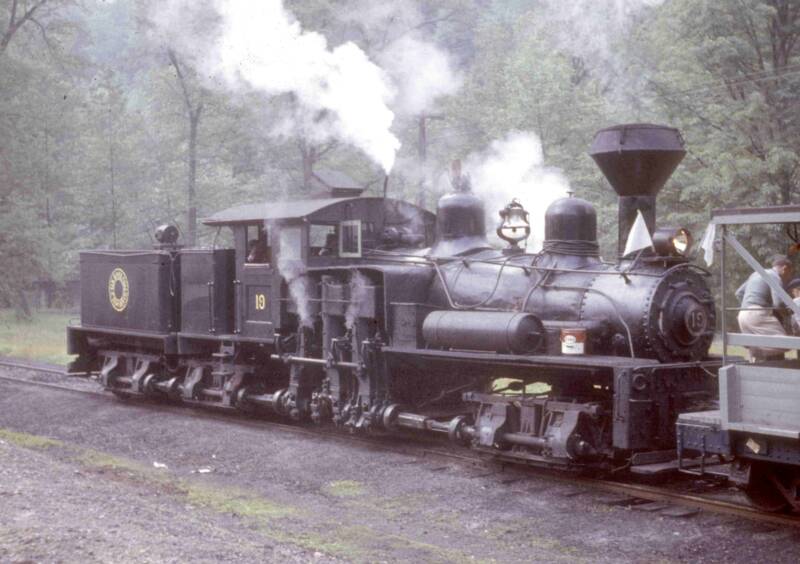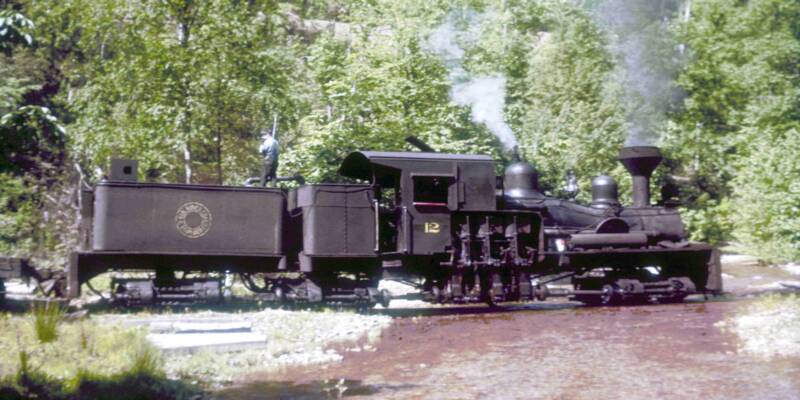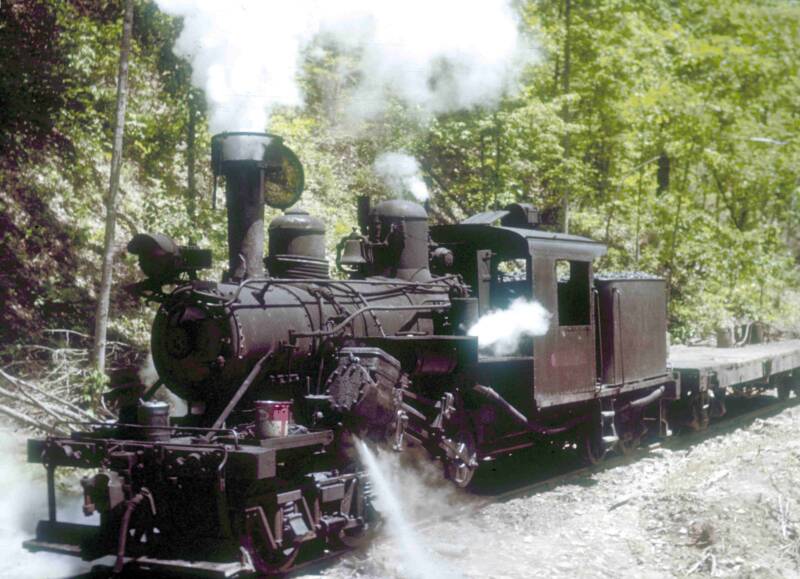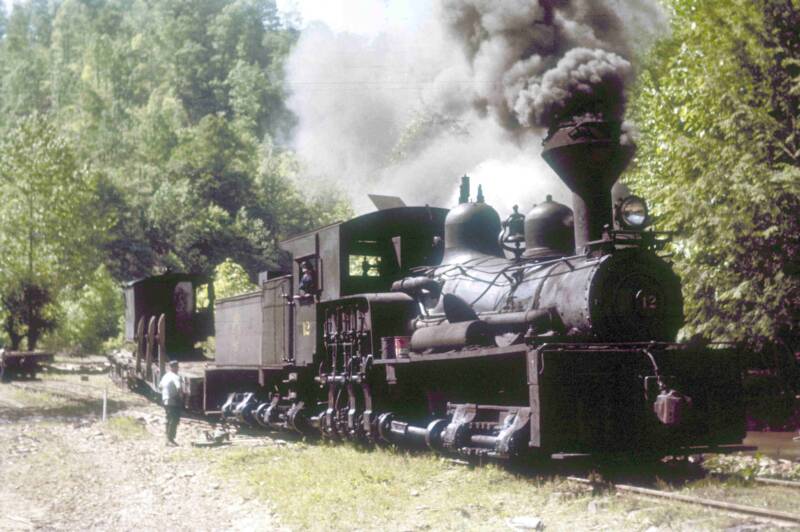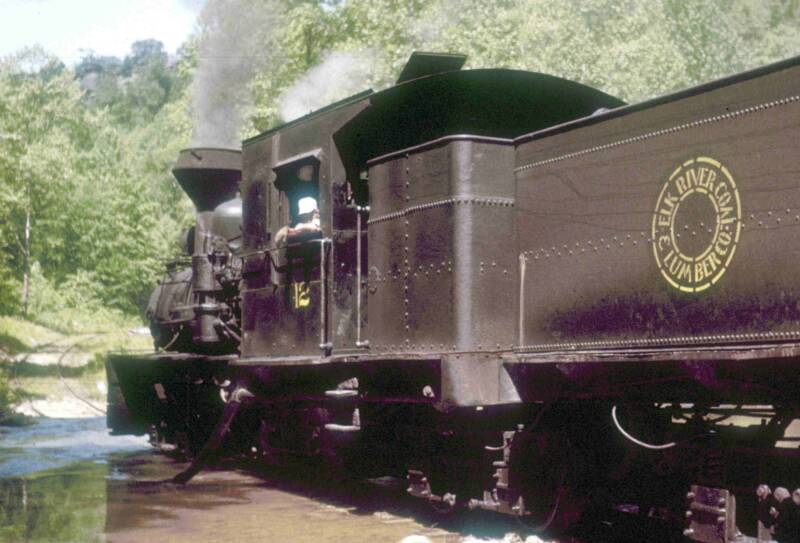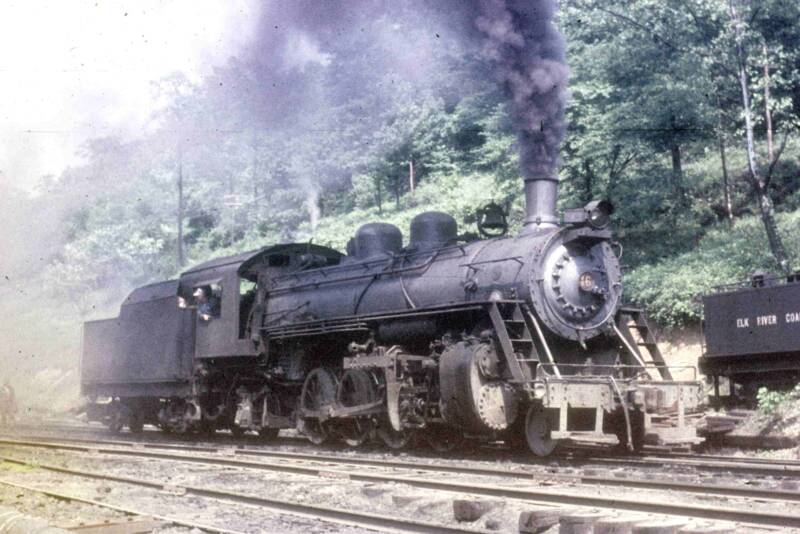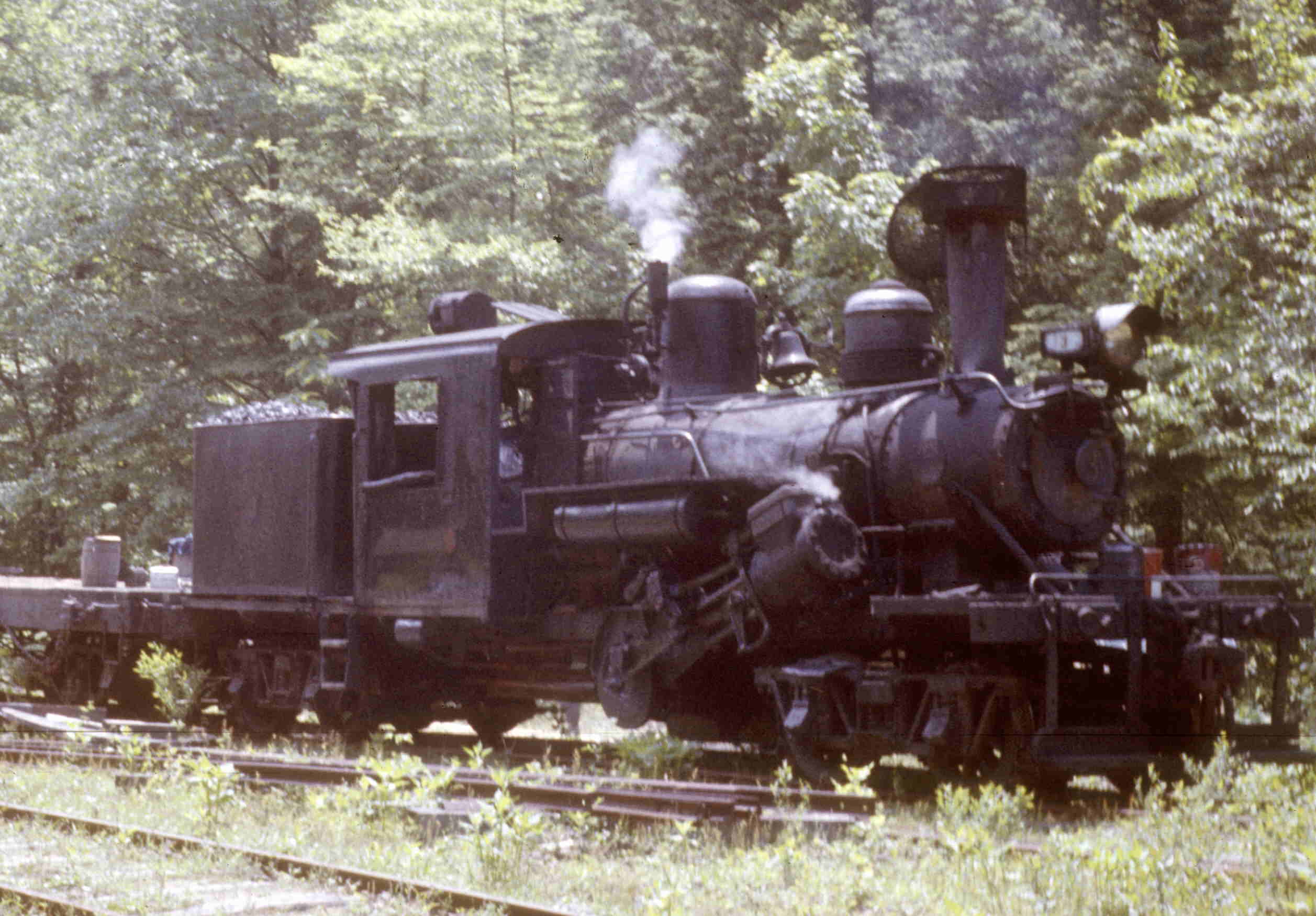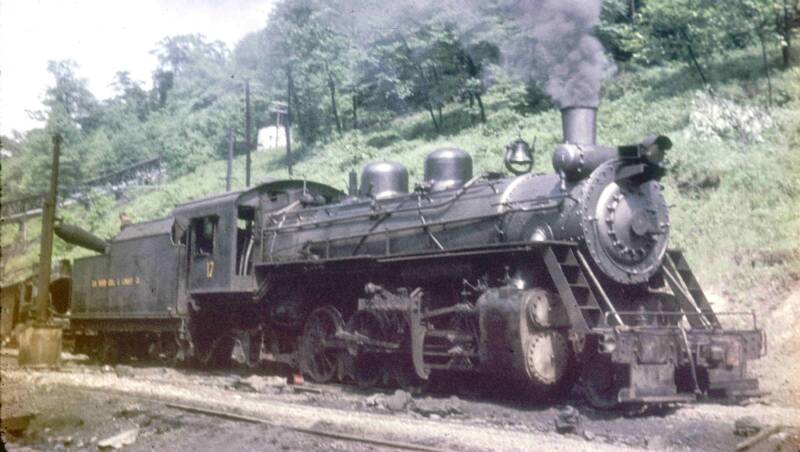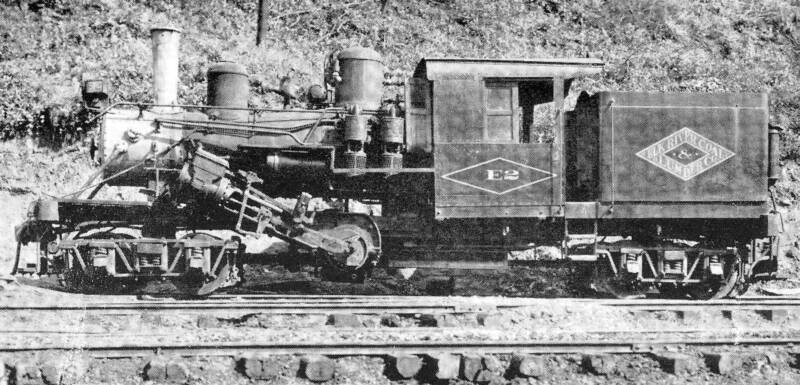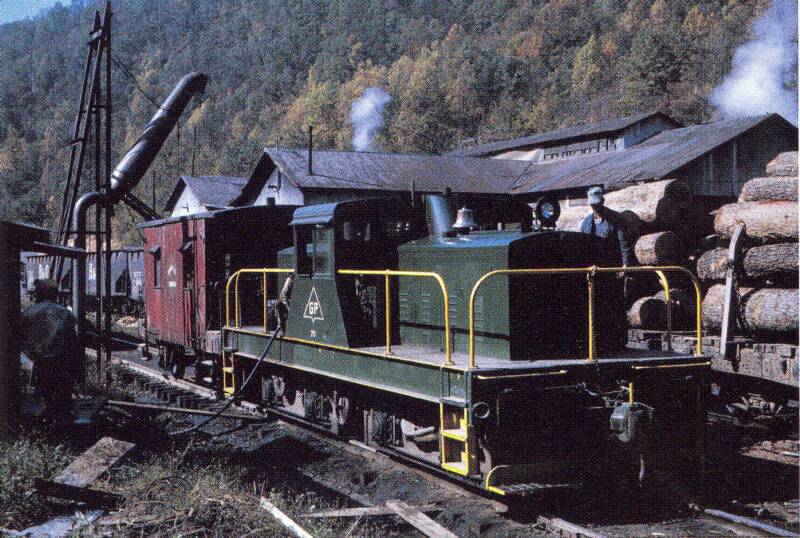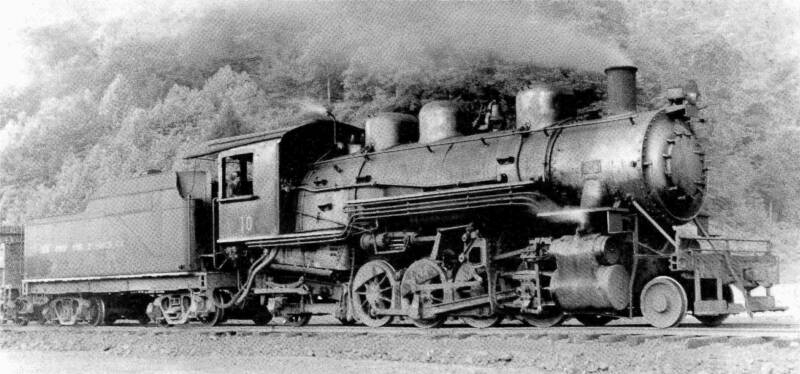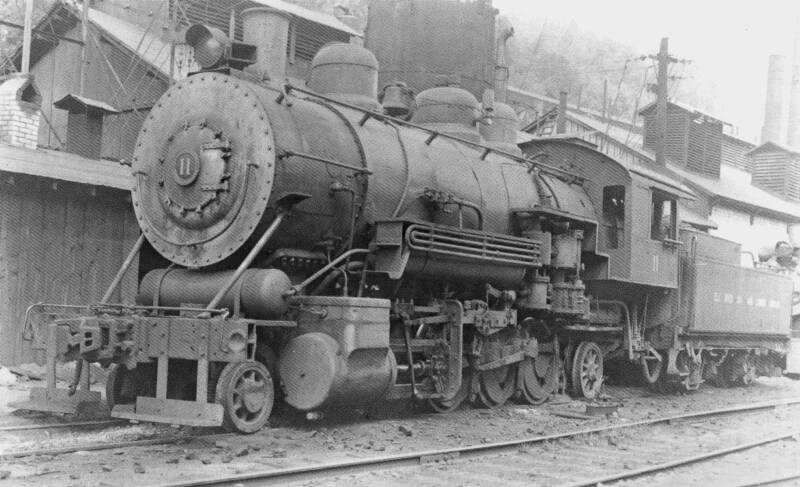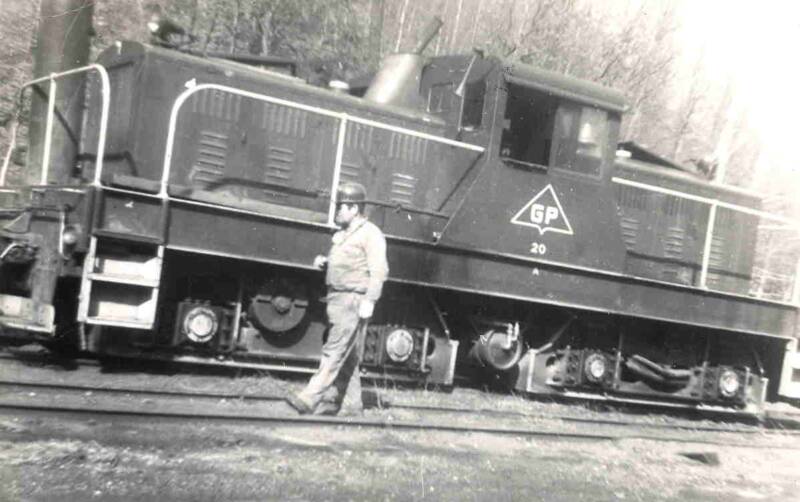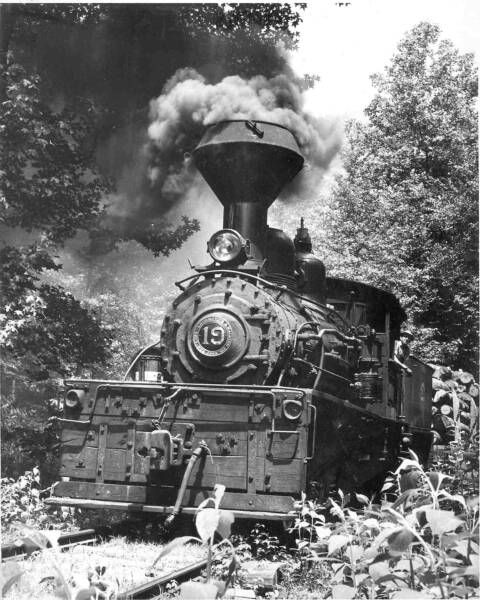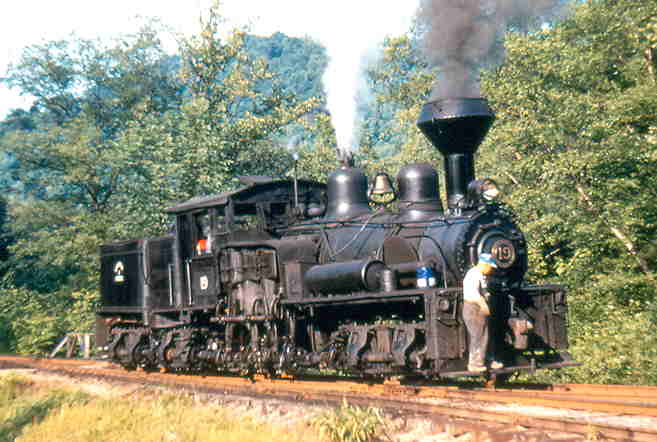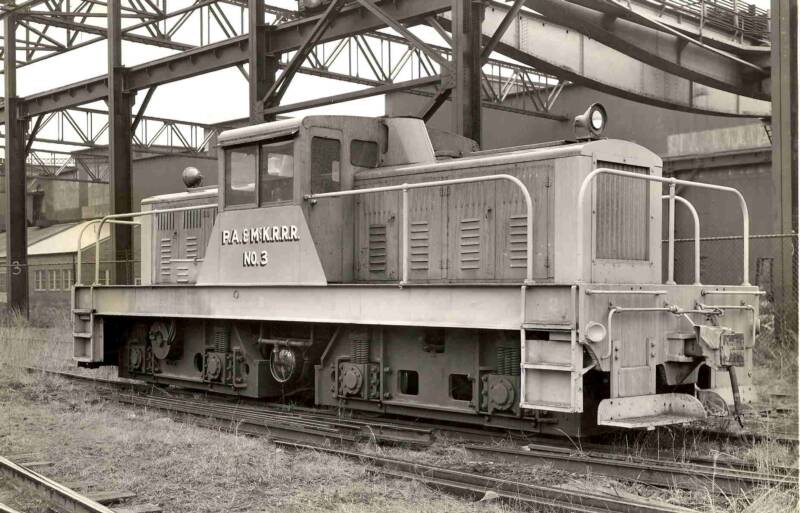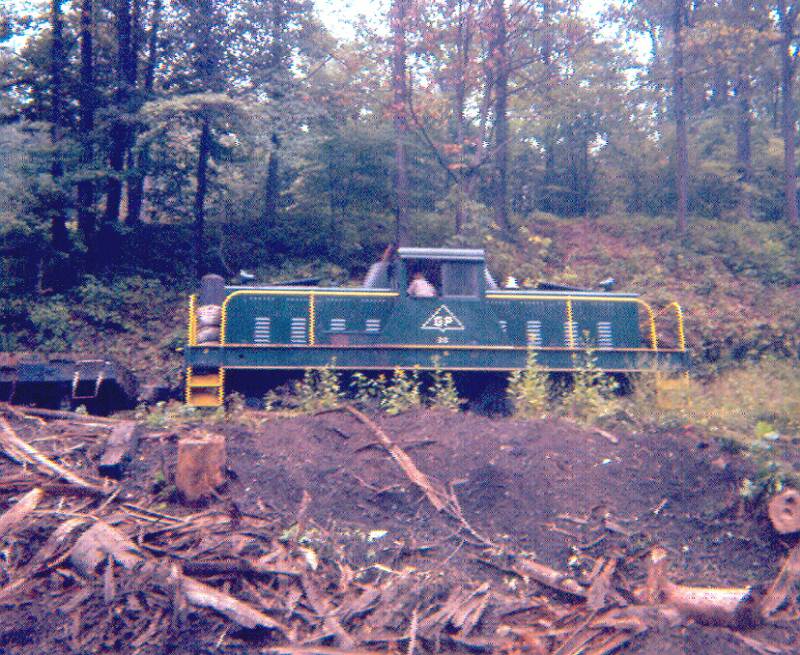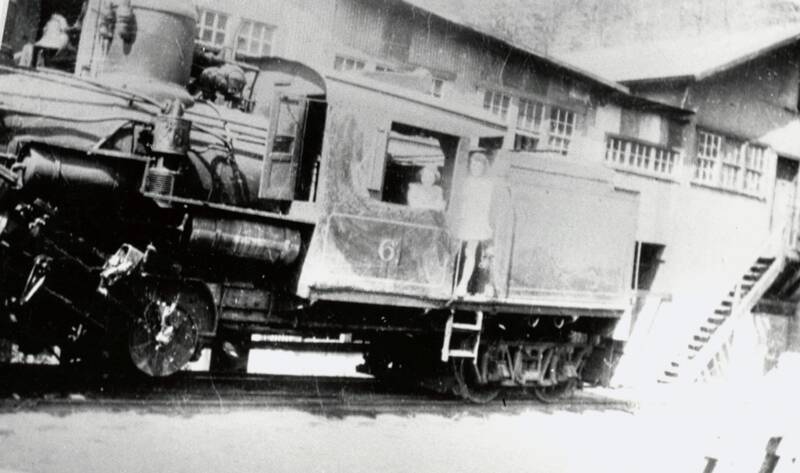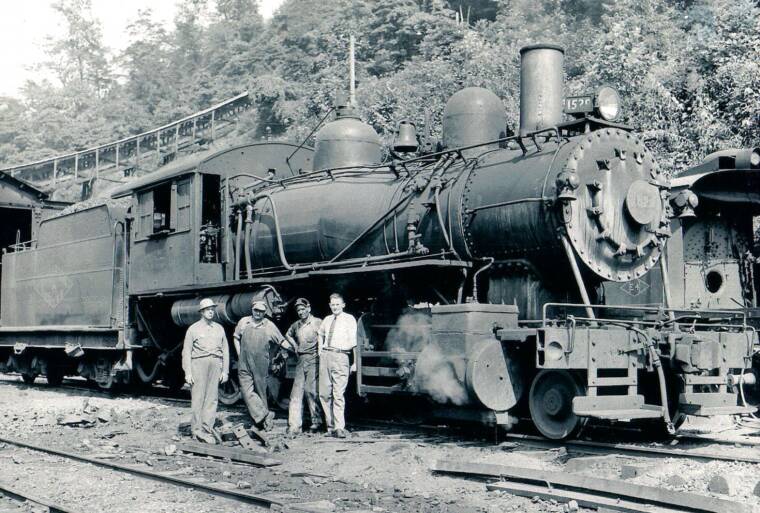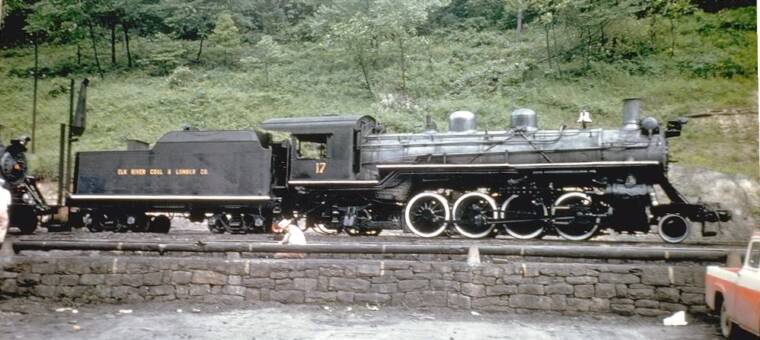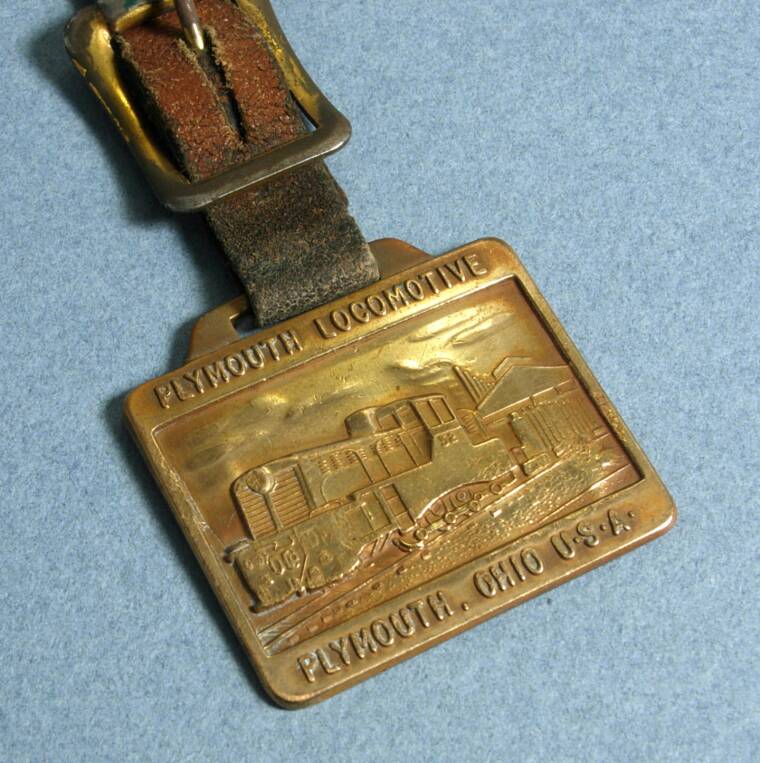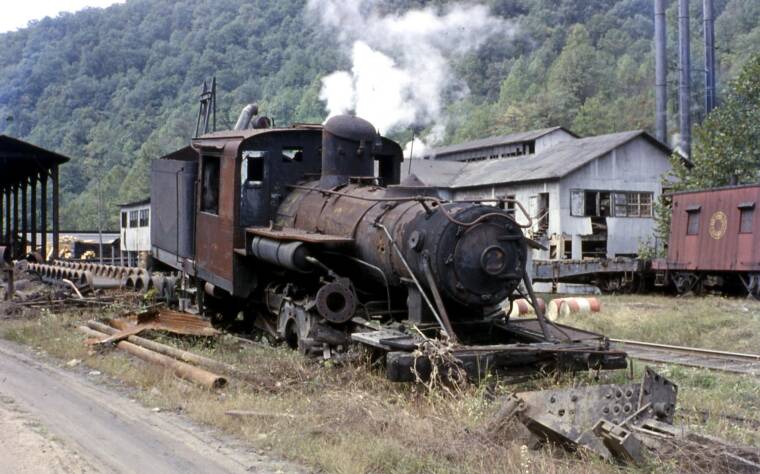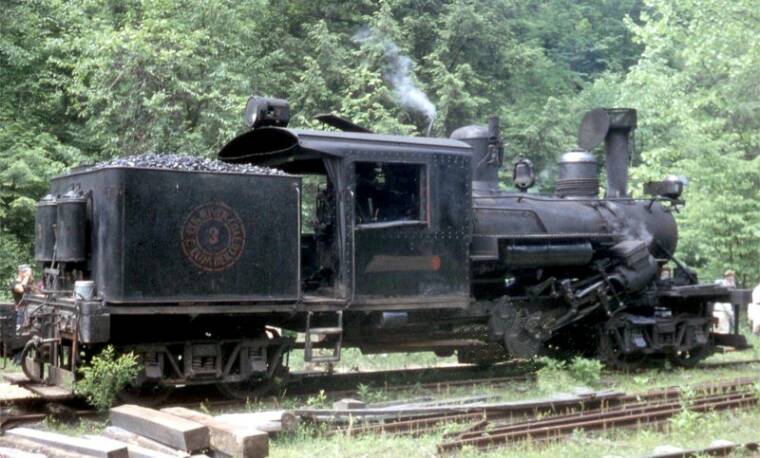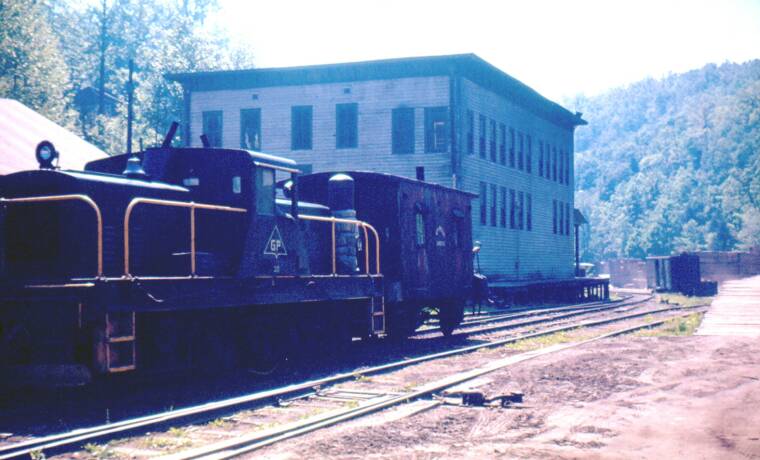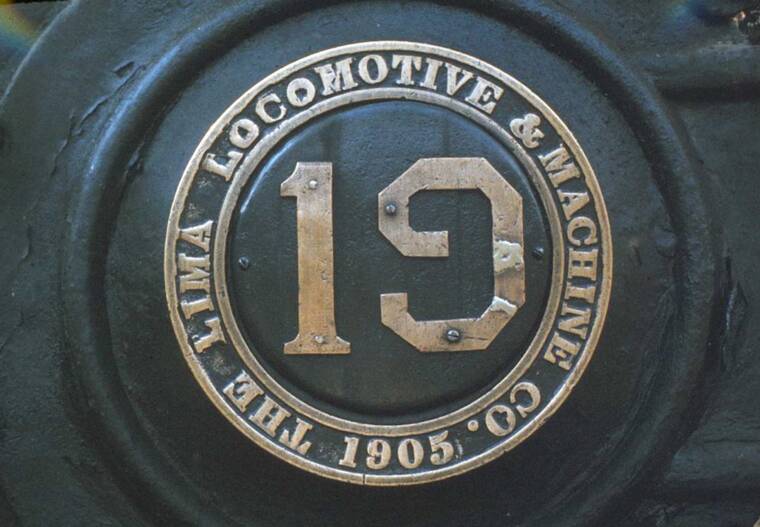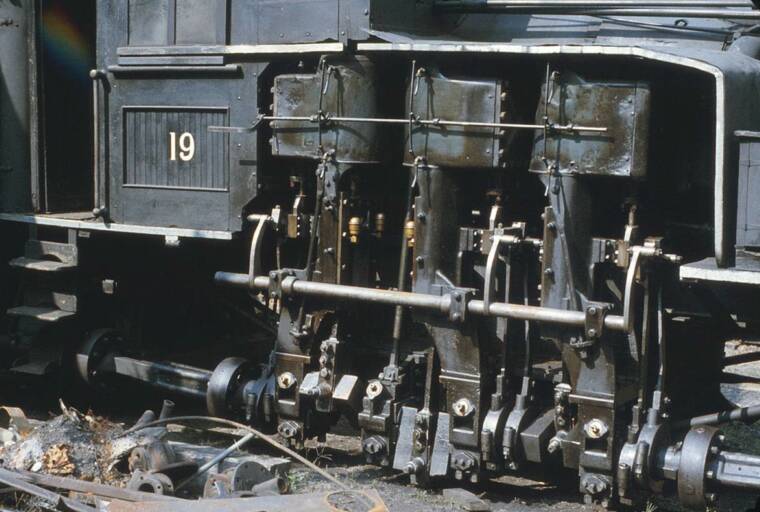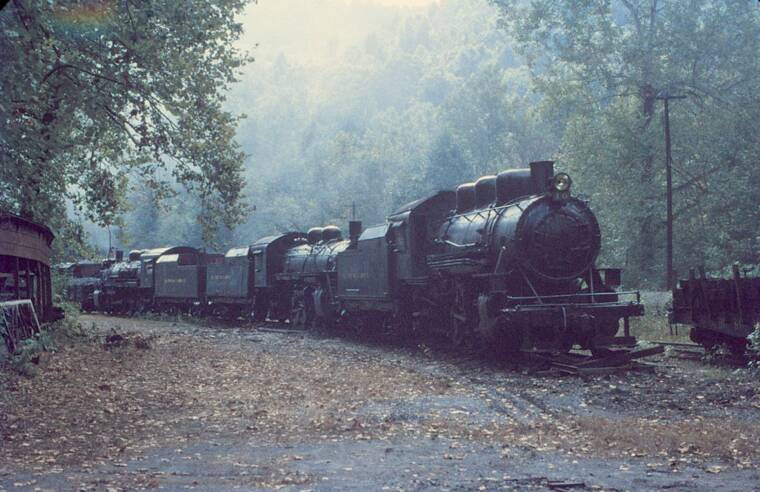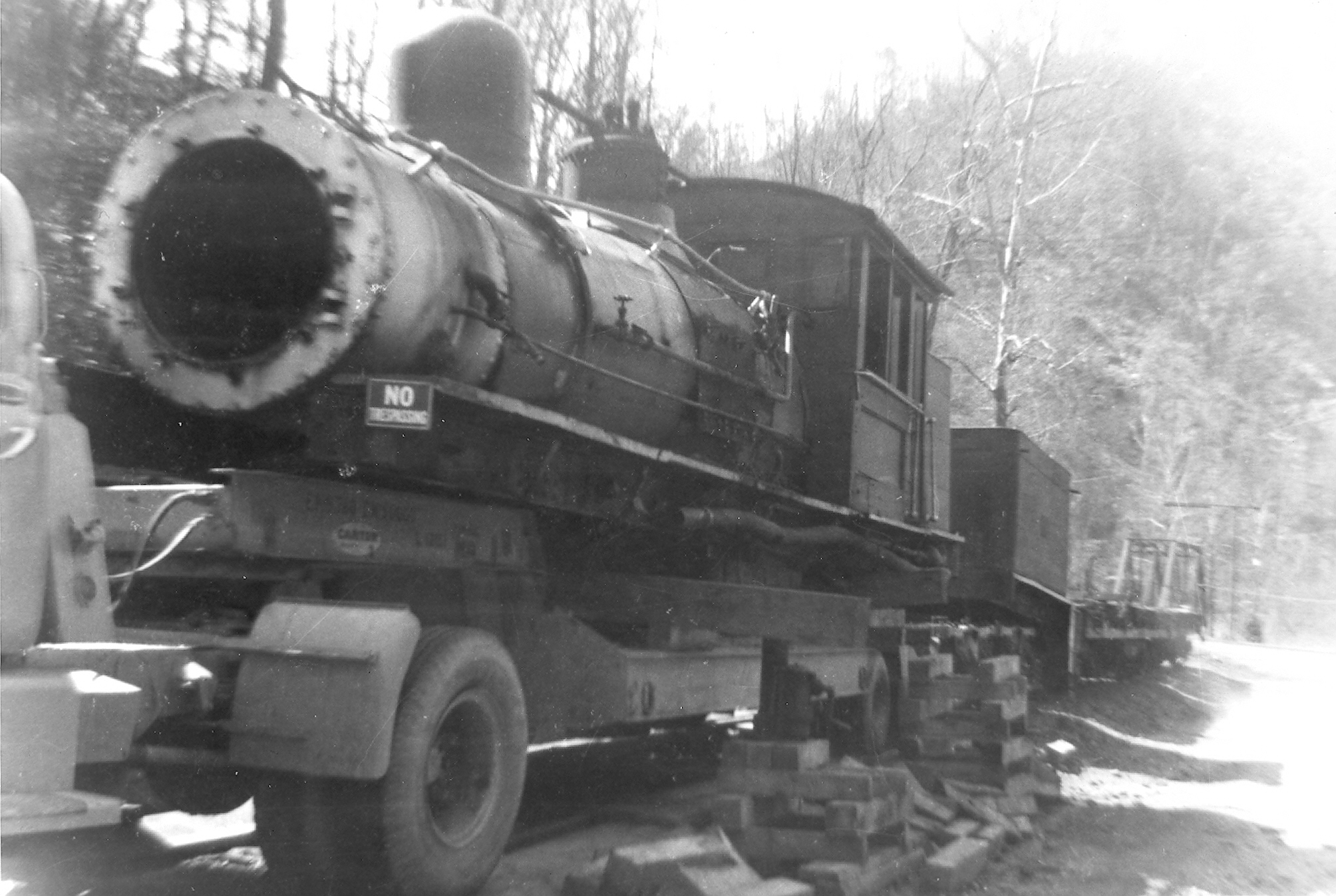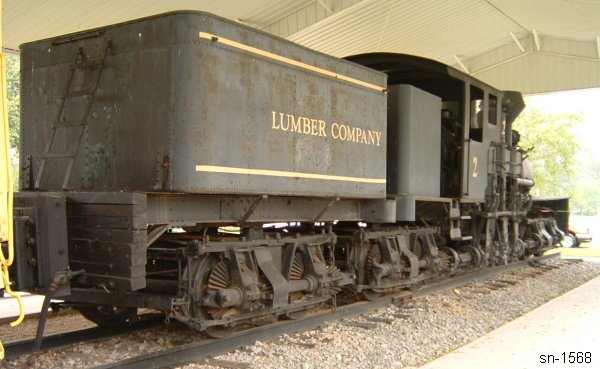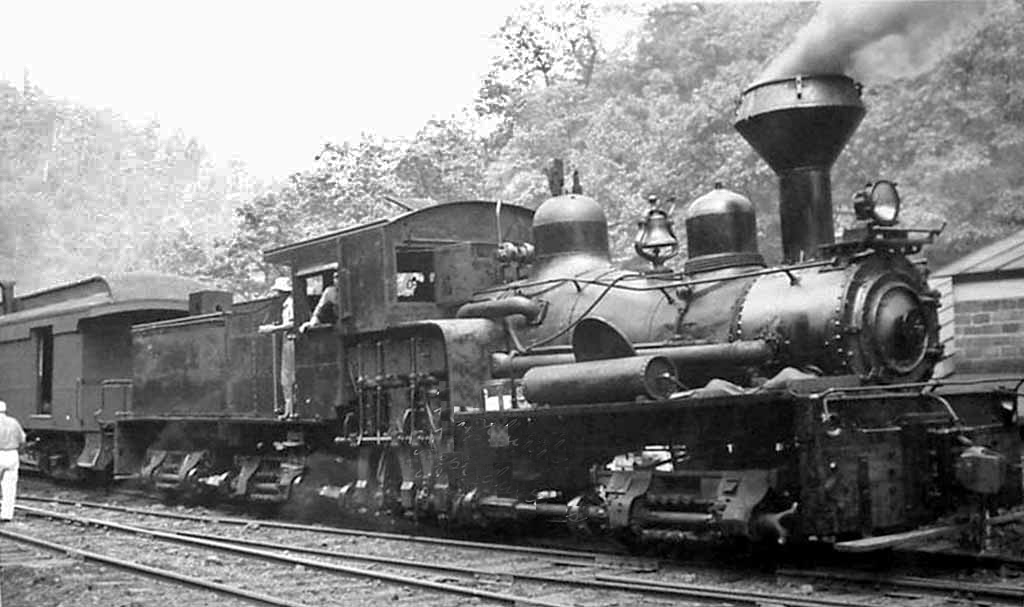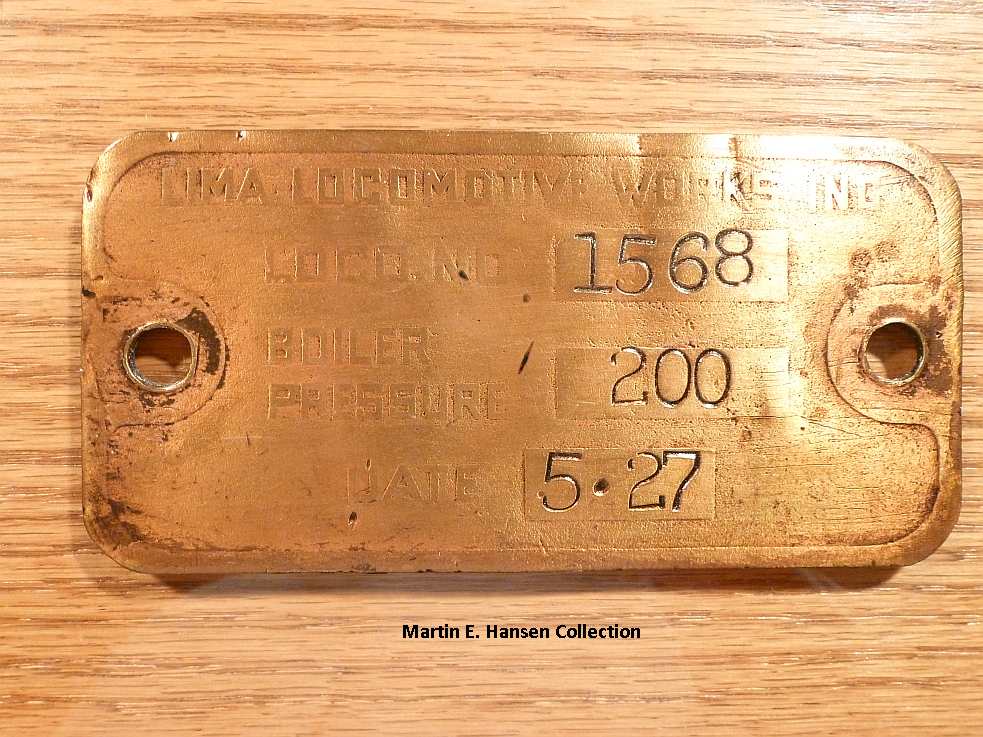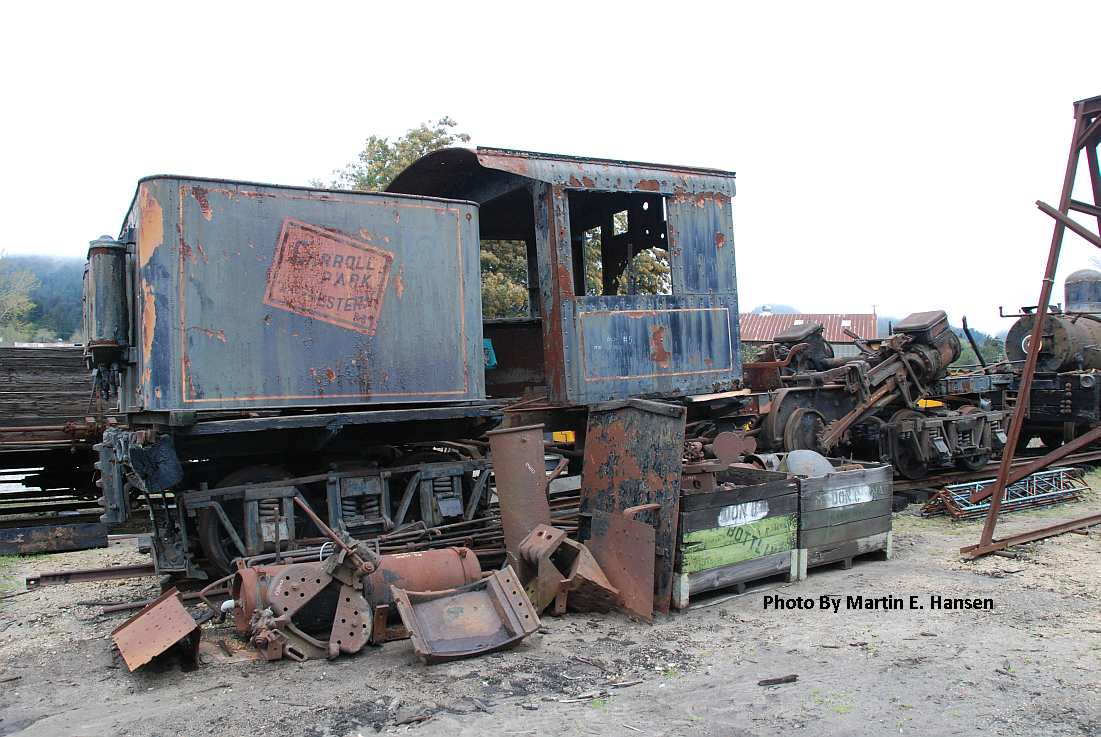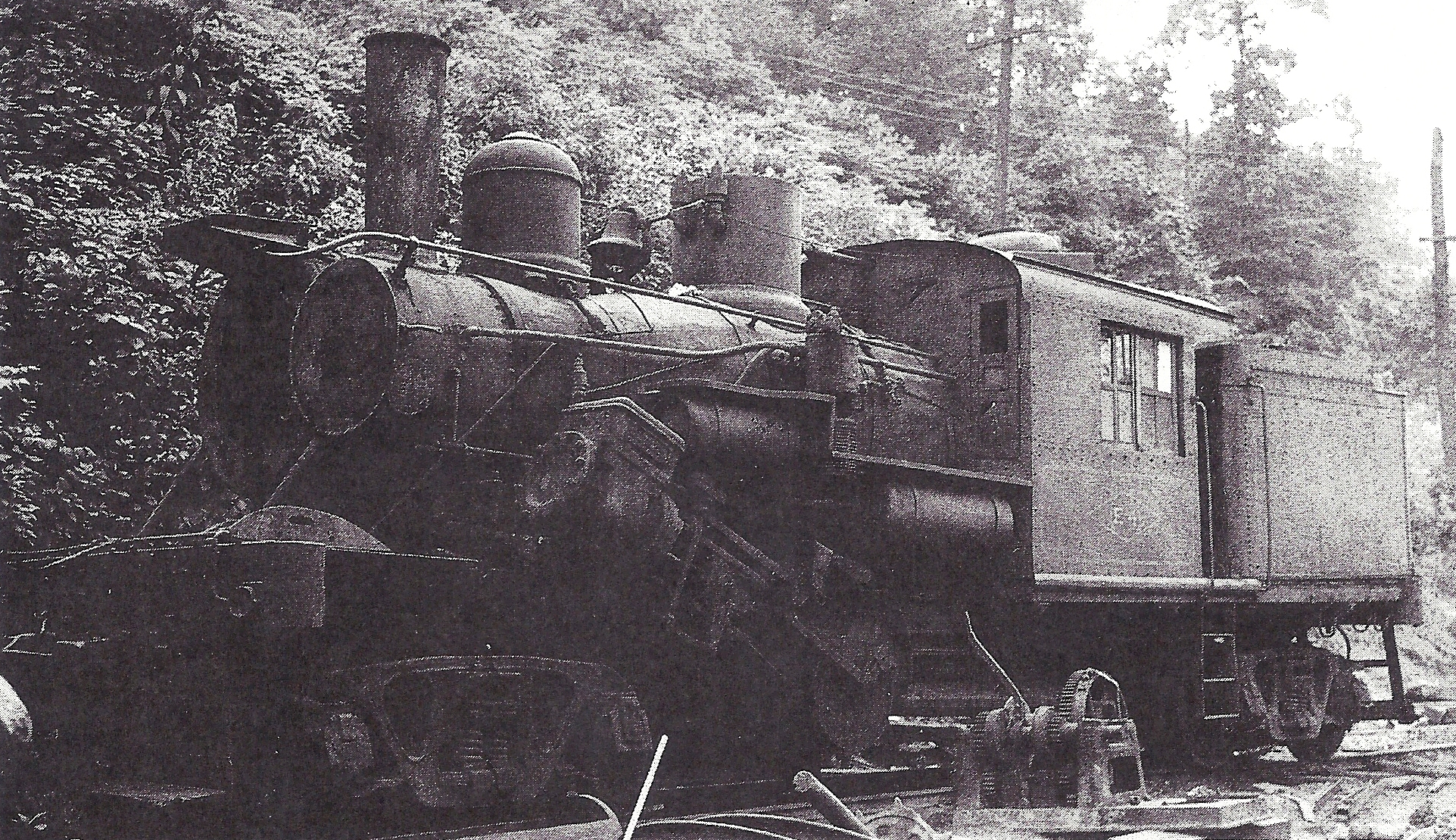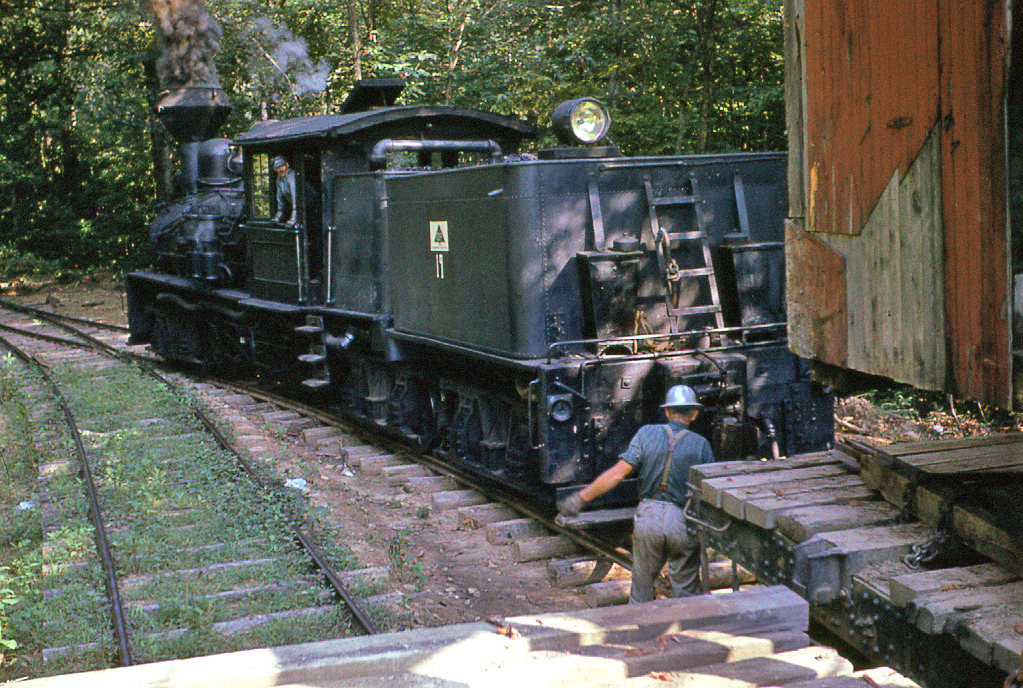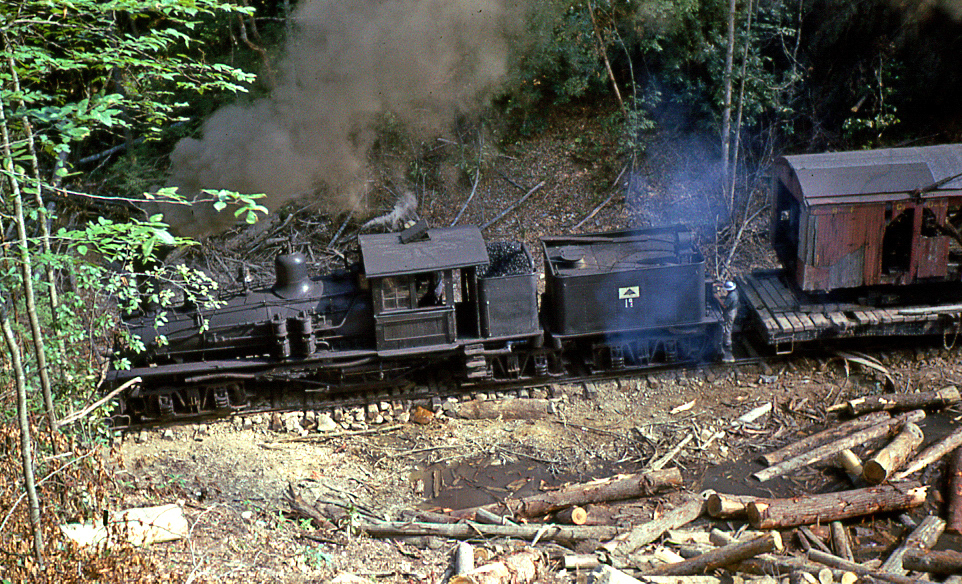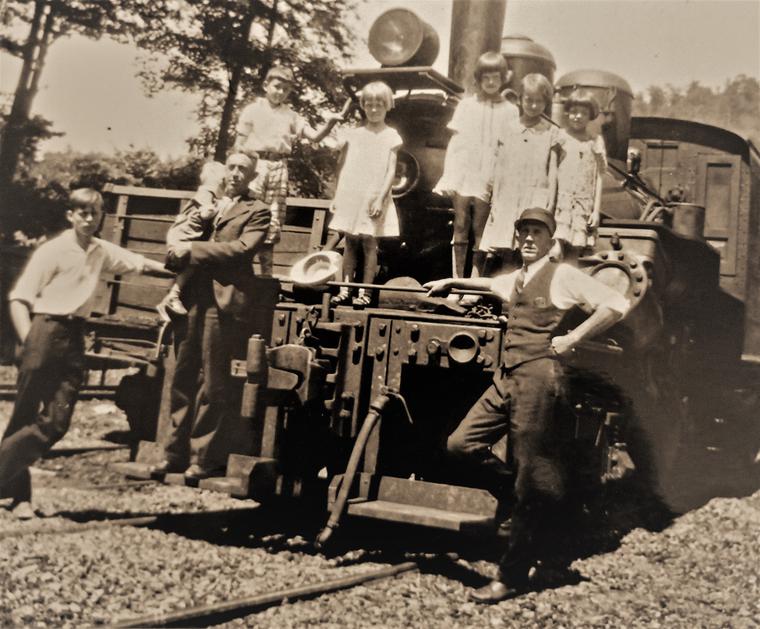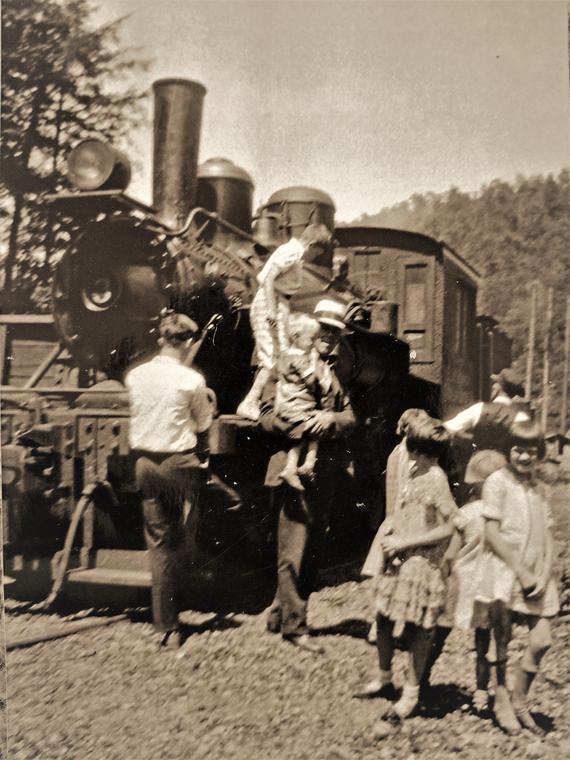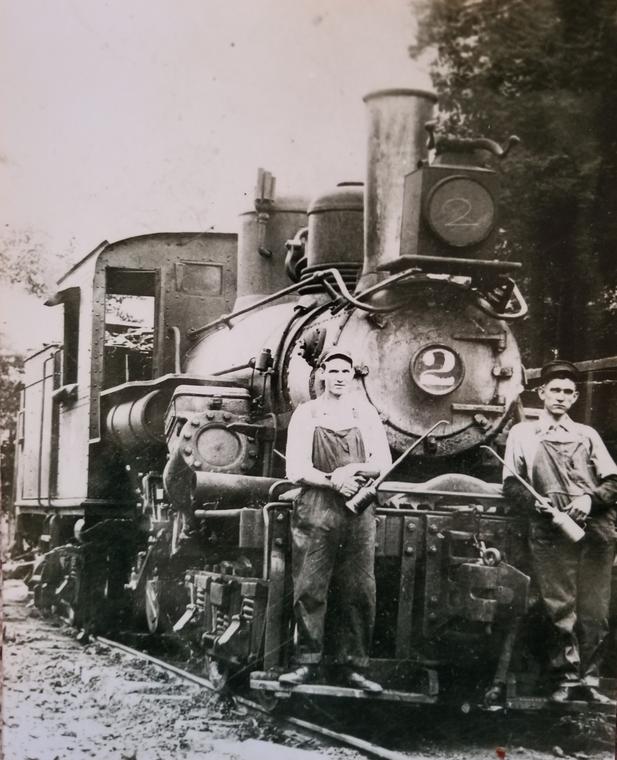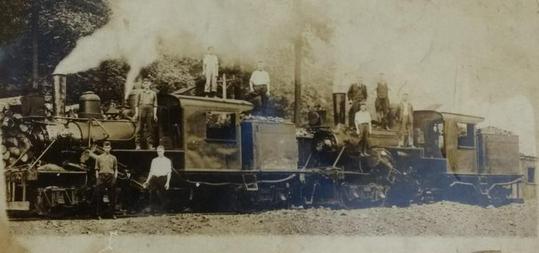ERC&L Locomotives
There are alot of photos of the ERC&L logging engines because so many folks made the trip to West Virginia in the final years of operation...it was the only game in town. However, most of the photos in circulation, including all the ones in Warden's BC&G book, are black and white. I've included color photos here where ever possible. Special thanks to Dave Marquis for getting five of the ERC&L engines on color film and making them available to put on this site!
The locomotive are presented here in numerical order. It appears that the engines were numbered in the order that they were acquried. That intersperses the geared engines that worked on the Lilly Fork logging branch with the Mikado's that worked at the Rich Run Mine. For some reason just the Climax engines are listed with an "E" in front of the road number (i.e., E-2, E-3, etc.) and share numbers with engines on the BC&G roster.
Climax #3 (E-3)
Shay #12
Mikado #16
Mikado #17
Shay #19
Climax # 2 (E-2)
This is the only photo I've ever seen of Climax #2 in other than derilict condition. This picture came from page 61 of Warden's BC&G book. It shows the 40 ton Climax in excellent condition and was apparently taken sometime in the mid to early 1920's. It is the only photo I'm aware of that shows that ERC&L engines at one time were adorned with a diamond logo.
This is my favorite ERC&L engine, period. First of all, it was bought new by the line in 1928 and was in service until the very end. It was condemened in June 1959 but was rebuilt by Richard Manning and his crews before being sold to the Carroll Park and Western tourist line as a 48" gauge engine.
What's more, she was the last Climax ever constructed. She carries c/n 1692. There were two Climax assigned higher c/n numbers but #3 was the last one to leave the shop, making her the last one ever constructed.
The markings are very weathered in these photos, however, #3 usually carried the circular ERC&L loco in red or in white on her coal bunker.
Mikado #9
Mikado #10
Mikado #11
What great photos Dave has provided! Could steam be coming from any more places than in the photo above? Dave's notes say these photo were taken on "fan trip". It must have been an informal event as I'm not aware that organized trips ever went into the woods. In any case, it must have been wonderful!
Sadly, #3 was in badly deteriorated condition at Roar Camp and Big Trees in California in the early 1990's and I'm not aware her condition has changed.
# 9 No known photo
# 10 was originally Toledo Angola & Western #100 and came to the ERC&L when that line dieselized in 1949. This engine is currently on display in Pullman Square in Huntington, WV at
# 11 went originally to Sewell Valley Railroad. She eventually became C&O #2911, then #30 of the Aberdeen & Rockfish before coming to the ERC&L. Note the BC&G's ubiquitos pilot-mounted air tank.
(These two photos from Warden's BC&G book)
Three more great pictures by Dave Marquis! Shay #12 started life as Lackawanna Lbr. #10, then went to the Emporium Lbr. Co. as their #10 and eventually became #40 of Heywood-Wakefield before joining the ERC&L. She was reportedly stored in 1958 (and scrapped in 1962), so these pictures were taken shortly before her tour of duty ended!
The picture to the left is interesting on two counts. First, the ERC&L yellow circular logo is clearly seen . Second, while it was a regular occurrence for the logging engines, this is the ONLY photo I've ever seen of the process of siphoning water from the stream actually in progress! The hose is just visible (arrow) below the air pumps.
Three photos Dave Marquis - circa 1958
Climax # 1 (E-1)
Leonard Brown has provided the only image I've ever seen of Climax #1. This photo, dated 1918, is from his family's collection. The Climax on the right in the photo is clearly identifiable from the number plate as #2, and given the oil headlamp, lack of appliances, and context of the photo, it can be assumed that the lead engine is #1.
Mikado #15
ERC&L #15 started life as Savannah & Atlanta #502 (#500 shown at left). The engine apparently was built to burn oil, but no record exists of when it was converted to coal. It came to the ERC&L directly from the S&A. This engine was out of service in the mid-'50's and was scrapped in 1961.
Climax #4 (E-4)
The only other image that confirms the existance of #4 is to the right. By enlarging this picture you can just make out the number #4 on the side of the cab of the derelict engine under the smokebox of the rod engine (yellow arrow). That rod engine is interesting in itself in that it has B&O #1529 on the engine but a BC&G tender. Note this photo shows #4 at Widen.
According to the Thompson, Dunn & Hauff book, the #4 had the following specs"
Boiler pressure: 200 psi
Cylinder bore: 14 1/2"
Wheel dia: 35"
Coal Capacity (as built): 10,000 lbs.
Water Capacity (as built): 2,600 gallons
At first glance these look like the same photo!
They are, in fact, two different photos of 'sister' locomotives, both coming from Baldwin with c/n's 57329 and 58683 respectively. Both also came from the Savannah & Atlanta.
There is some confusion about when these engines arrived at the ERC&L. One source suggest 1955, but page 74 of Warden's BC&G book has a photo of #16 dated 1951. The 1955 date reasonale since the locomotives were numbered sequentially and Shay #19 was acquired in 1957.
The feedwater heater on #17 is inoperative. The 1951 photo of #16 mentioned above shows it with a heater, as well.
The photo of #17 below, from Mike Rowe, was taken when she was spiffed up for the 5/31/58 railfan weekend! She certainly didn't look like this in normal service but the photo shows her handsome lines.
Two photos Dave Marquis - circa 1958
Shay #18
Shay #19
In once sense, ERC&L Shay #18 never existed. In 1957, Cherry River Boom & Lumber #7 was purchased by the ERC&L but was never put into service. According to Cody Burdette, it was never painted in the Elk River livery. It was scrapped for parts in 1960. For more, see 'Shay Stories' below.
Like Climax #3, this handsome Shay has a certain "claim-to-fame". It is believed to have been the last Shay in regular logging service. The Killoran roster published in the August 1962 TRAINS magazine indicates she was in service in that year and photos from the 1963 railfan trip show her for sale. So it appears she operated up until 1962 or early 1963.
She began her life on the roster of Tioga Lumber and then went to Cherry River Boom & Lumber where she was their #2. This Shay came to the ERC&L in 1957 at the same time they bought ill-fated CRB&L #7 (see ERC&L #18). She went into service in 1958. See 'Shay Stories' below.
Plymouth #20
David Marquis photo - circa 1958
Photo from the collection of Robert Caruthers
It is fortunate for ERC&L fans everywhere that a wonderful gentleman named Cody Burdette has shared with me many stories about Shay #19, maybe the most famous of all the ERC&L engines. It is with his permission that I am re-telling them here for everyone to enjoy, but more importantly, with the hope that they not be lost to history. Cody worked on the ERC&L geared engines from 1956-1959 and his dad, Ted Burdette, was a long-time ERC&L engineer.
Acquiring the Shays in 1957 and Why #18 Never Was Used
Long after other roads had abandoned steam, the ERC&L was out acquiring steam engines. In his wonderful story in the Spring 1988 GOLDENSEAL, Cody recounts how he and another crewman, Raymond Davis, made the trip to Richwood, WV in the winter of 1957 to pick up CRB&L #2 and #7 and ride with them as they were towed in a B&O steam train to Dundon. It is a wonderfully written story. What is not in the article, however, is a piece of this piece of the story. Cody says that at one point during a coupling manuever in Burnsville, "a B&O engine hit #7 so hard when he coupled to me, I thought he broke something, and he did, for when it arrived at Swandale they discovered the frame was broken. That is way the engine was never put into service. It became #18 and CR&L #2 became #19. The trucks were better on the 18 so they put them under the 19."
Shay #19 Cab Fire
Cody was a hostler on one of the night shifts at the sawmill. He passed along this fascinating story, too. By Cody's account "one night on the other hostler's shift, the cab burned off of #19, so they put the 18's cab on the 19. The were both wooden cabs." Cody further suggested that the fire might very well have been caused by the other hostler who was known to drink during his shift!
Starting the Shay in WInter
Cody Burdette spent many winter nights tending #19's fires. He recalls that "on cold winter nights she would freeze to the rail. To get her loose, I would open the throttle a little, and move the reverse bar back and forward. That way the slack in her gear train would break the ice."
Shay Stories
Holy mackerel! A diesel on the ERC&L!
According to Cody Burdette, Plymouth #20 arrived on the scene in the early 1960's. This is consistent with the information in the Gondola Gazette for the 1960 fantrip that notes that a "small diesel" was on the property at Swandale in May of 1960.
.
However, the September 2003 issue of TRAINS magazine reports that the 44 ton Plymouth was purchased by Georgia Pacific in 1962. Further complicating matters, the March 1961 issue of Steam Locomotive & Railroad Tradition, pg 4, reports that "the Georgia Pacific (recently) disposed of a 4-wheel diesel mechanical Plymouth locomotive". The locomotive in the photo is obviously 8-wheeled. The only conclusion is that the exact date engine #20 arrived is not certain and I don't know what engine Steam Locomotive & Railroad Tradition was referring to.
There does seem to be agreement that the diesel #20 came from the Pittsburg, Allegheny & McKees Rocks Railroad in Pennsylvania.
There are very few photos of the engine and this one by Neubauer from the TRAINS article is by far the best color image I've seen. That's Theodore Burdette standing on the engine. He piloted the locomotive after the #19 was retired, but according to his son, Cody, Ted never liked the diesel!
Note in the upper b/w photo what appears to be a large air tank located on the running board in front corner. Notice, too, that both this engine and the BC&G 65-ton Whitcomb were both numbered 20.
The engine operated until the mill closed in 1968,
Be sure and check the ERC&L Logging Operations page for some great stories about how the diesel performed in logging service!
James A. Neubauer - Oct 1962
John B. Allen photo, collection of Thomas Lawson - August 1956
No Photo Available
John Allen photo, collection of Thomas Lawson - Sept 1955
Railroad Museum of Pennsylvania photo
Two photos from Cody Burdette collection
Cody Burdette collection
Al Chione collection
Here's #19 in her W.M Ritter livery. The crewmember standing on the pilot is typical of both the ERC&L and BC&G. Note the glistening number plate! Cody Burdette reports that his dad always kept the bell and number plate shining!
This photo is of #20 while still #3 at the Pittsburg, Allegheny & McKee's RR
STEEL CAB ON #12
Cody Burdette remembers that it was Sam Caruthers, father of well-loved BC&G hostler Bobby Caruthers who built the steel cab for #12 when the original wooden one wore out.
John Taubeneck, a long-time fan of West Virginia logging railroads has provided some history on #20, including some previously missing information.
Built by Plymouth in October of 1942 as C/N 4426. It had a 300 hp engine. It was originally owned by the Pennsylvania Ordinance Works of Allenwood, PA, then went to the US Army at Ft. Holabird, MD, then to the US Steel Corp. in Trenton, MI. In 1954 the engine was owned by Cole-Layer-Trumble Co. of Dayton, OH and then to the Pittsburg, Allegheny & McKees Rocks RR before arriving at the Georgia Pacific Swandale operation in 1962.
The photo to the lower left was found on the internet by Mike Rowe and forwarded to me. It shows Shay #19 on display in Herrod, OH under a roof. The date of the photo and the photographer are not recorded.
Besides the rear mounted sand boxes, the drive shaft between the second and third trucks seems to be missing. Also, the configuration of the rear beam is strange, looking like it's set up for link couplers, but at least she's out of the rain and snow!
Cass Scenic RR was interested in buying her and sent Artie Barkley to Lima to inspect her, but he found the boiler to be in bad shape. Artie indicates that at that time she was stripped of many of her parts.
Here's a rare color photo of #20 in action with at least one flat car in tow. This photo was taken by a Canadian railfan by the name of John Brown during one of his visits to the BC&G. The photo was snapped near Swandale.
John Brown photo, circa 1963
LILLY FORK "CANNON BALL" - by Cody Burdette
Cody Burdette solved the mystery of the faint linear markings visible in the two Marquis photos of Climax #3 above. For the longest time I just assumed they were fade paint marks or repainted sections over repairs. But Cody reports that Raymond Davis, one of the engineers on the Climax nicknamed the engine the "LILLY FORK CANNON BALL"! This despite the fact that the engine's top speed was somewhere around 12 mph!
So one day Raymond paint a cannon ball trailing flames on the cab of #3. That's what can be seen in the photos, though faintly. Cody recalls that the coloring was about the same as the ERC&L structures....oxide red.
Climax #6 (?)
I guess this would be classified as a mystery engine. This Climax is clearly numbered 6 (although there are no ERC&L markings) and it is clearly at the Swandale mill, but there is no other reference I've seen to an ERC&L Climax #6. One possibility is that this is the 3-truck engine #4 after it was converted but that doesn't explain the #6 on the side.
This photo, that appears to be more about the girls than the locomotive, is from the Bobby Caruther's collection courtesy of Doug Andre.
Click here for more info on this Plymouth watch fob...
Photo by John Phillips October 2, 1958
I really enjoy this photo, especially because it is in color and shows the patina of the weathered engine so well. The smoke from the sawmill in the background makes it almost look like #2 is under steam!
This photo was found on the internet. The date and photographer are unknown. I have added it to the site because it shows the 'cannonball logo' on the cab and the ELRC&L circular logo on the tender more clearly than either of the two Marquis photos. The ERC&L logo is in red in this photo as it is in at least one other in my collection. Also visible clearly are the dual sand boxes on the rear of the tender.
Robert Amon captured #20 near the Swandale compnay store in June 1963, The store would have been closed for about 4 years by this time. Notice the large tank on the deck of the engine. Cody Burdette believes it might have been a reserve water tank for the engine's radiators. Notice that it appears the four wheel caboose was still in use.
These two details of #19 were photographed by Doug Wingfield in 1962. The number plate photo is particularly fascinating as careful inspection reveals that the center portion with the engine's number has been fabricated and attached over the top of the original cast-in number! This explains the unusual form of the digit "9".
The End of an Era
I love this 1961 photograph by Doug Wingfield for several reasons. First, the light coming through the haze gives a ghostly feel to the image. Second, it's taken from a vantage point rarely seen...the very back of the sidings at Dundon. Third, there is some kind of structure to the left of the frame that I've not seen in any other picture. The three engines are, of course, ERC&L #16, #17 and #10 (nearest camera). These engines were retired after the sale of coal operation when gob began
Doug WIngfiled October 1961
But CODY BURDETTE has the WHOLE story! Cody reports that his father, Theodore made the "1" and the "9" in the Swandale shop out of brass from a whistle that was at one time on Shay #12. One day while blowing for the Cressmont crossing, the top blew off the whistle! Theodore retrieved the top a few days later, discovered it was too badly damaged to repair and so used the brass to fabricate the numbers which were put on #19 when it arrived on the property. The number underneath is #2, the locomotive's number when she was on the Cherry River Boom & Lumber, her prior owners.
As was the case with other BC&G and ERC&L equipment, the fact that the railroad operated so late into the steam era worked in favor of saving so much of the equipment. Cody Burdette provided the photo on the left which shows Shay #19 being loaded onto a flatbed truck for transporting to the Big Walker Mountain RR, a 2-mile long tourist railroad. The BC&G towed the engine to this point near where the B&O station stood for loading. The photo was taken sometime around 1963, Cody believes. The B&O truss bridge is just visible in the background behind the flatcar.
After a short stay at Big Mountain, the engine went to Florida and then to Lima, OH where it sat in the old Lima shops where she was built.
This photo was found on the internet. It is interesting on two counts. First, the photo is dated May 29, 1955 and that date plus the consist including coach/dining car X-6 indicates this was a railfan trip. There are few photos of this event. Second, notice that there is a U-joint yoke on the front of the front truck indicating the shaft was originally on the center truck of a three-truck Shay, perhaps the other engine that came from the Cherry River Boom and Lumber.
Photographer unknown May 29, 1955
Martin Hansen has this backhead builders plate from #19 in his collection. It was reportedly removed from the engine before it left the railroad property but was sitting out of service. It appears that it was wiped down many times!
Martin Hansen photo
Sadly, the years have not been good to #3. While she still exists, she is in parts and without a boiler at Roaring Camp and Big Trees RR in California. This photo was taken by Martin Hansen in March 2011.
Martin Hansen photo March 2011
Steve Ackerman has done some research and uncovered what seems to be the most accurate information about Climax #4. The engine was built in March 1920 as a standard gauge class C-70 for the Spice Run Lumber Company of Locst, WV as their #5. She then went to Dawkins Lbr. before being purchased by the ERC&L in 1943. By most accounts at some point the ERC&L converted #4 to a two-truck engine making her basically a class B-60 Cody Burdette says #4 was used as a gob engine in WIden and occasionally as a helper on the coal train between Swandale and Widen. There are no known photos of #4 as a three truck engine. It was sold for scrap in 1950.
The photo to the left shows #4 on temporary trucks at Swandale in preparation for sale for scrap.
2 Photos by Frank Fieler 8/16/61
Frank Fieler took this nice photos of #19 , both from the less photographed left side. These images show that the pipe for transferring siphoned water to the tender was enclosed in the left rear corner of the coal bunker.
Notice that in both of the Fieler images above the CRB&L crane is in service. For another image of this crane by Frank go to ROLLING STOCK-ERC&L. Notice, too, that the #19 is now wearing the GP logo so the crane was in service during their operation.
CLIMAX #3 WHEN NEW!
JC Sirk provided these two images which were in his mother's collection. Brenda Conner SIrk was the daughter of Bud Connor, superintendent of the sawmill. These photos are believed to have been taken in 1926 upon the arrival of the new #3 on the property. If so, these are the oldest known images of the engine!
This photo was provided by JC Sirk. It shows Climax #2 as she appeared in 1926. The photo is believed to have been taken in Swandale. Delbert Connor is on the right. The man on the left is unidentified.
6/8/21
